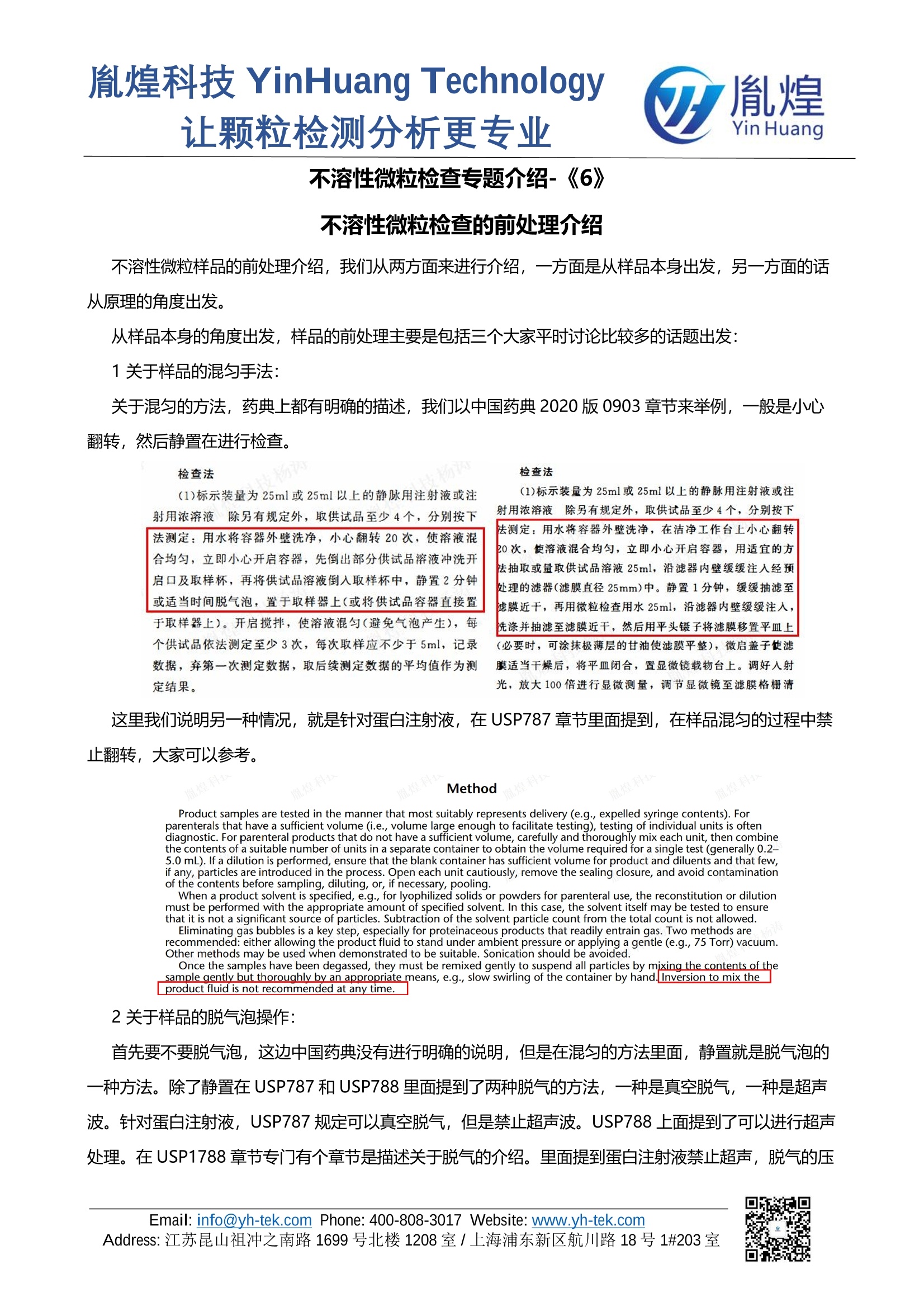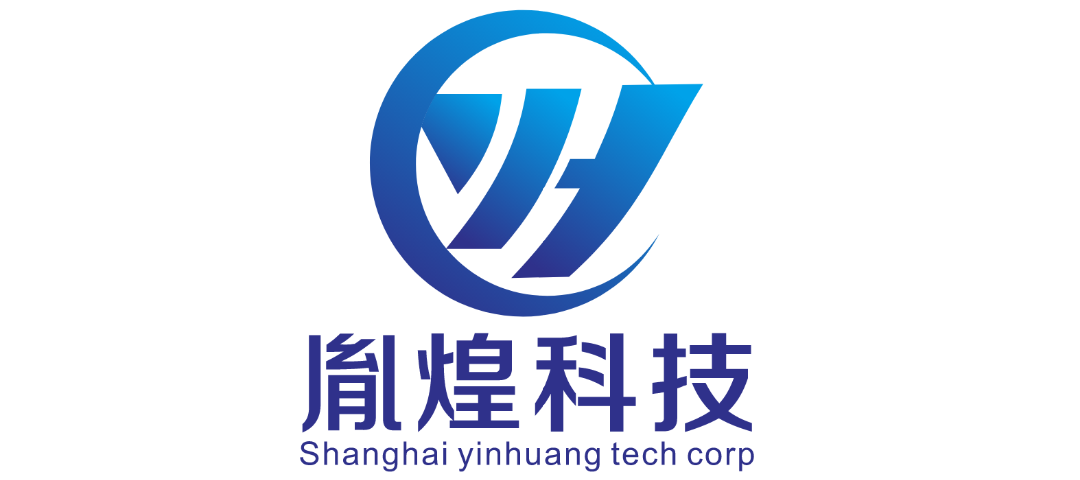方案详情
文
不溶性微粒检查样品的前处理介绍,我们从两方面来进行介绍,一方面是从样品本身出发,另一方面的话从原理的角度出发。
方案详情

不溶性微粒样品的前处理介绍,我们从两方面来进行介绍,一方面是从样品本身出发,另一方面的话从原理的角度出发。不溶性微粒样品的前处理从样品本身的角度出发,样品的前处理主要是包括三个大家平时讨论比较多的话题出发:1 关于样品的混匀手法:关于混匀的方法,药典上都有明确的描述,我们以中国药典2020版0903章节来举例,一般是小心翻转,然后静置在进行检查。 这里我们说明另一种情况,就是针对蛋白注射液,在USP787章节里面提到,在样品混匀的过程中禁止翻转,大家可以参考。2 关于样品的脱气泡操作:首先要不要脱气泡,这边中国药典没有进行明确的说明,但是在混匀的方法里面,静置就是脱气泡的一种方法。除了静置在USP787和USP788里面提到了两种脱气的方法,一种是真空脱气,一种是超声波。针对蛋白注射液,USP787规定可以真空脱气,但是禁止超声波。USP788上面提到了可以进行超声处理。在USP1788章节专门有个章节是描述关于脱气的介绍。里面提到蛋白注射液禁止超声,脱气的压力和时间,欢迎大家去关注。3 关于稀释的操作:首先无论是中国药典还是USP都提到,对于一些特殊的样品都可以进行稀释之后来进行检查,那么到底稀释多少倍,怎么稀释才是比较合理的,这个是我们经常更加关心的问题。这边我说点我个人的意见,首先我们一般还是不建议稀释,如果必须要稀释是不是可以选择其他的方法比方说显微计数法。那么如果要稀释的话,USP787里面提到一段话大家可以参考,如果选择稀释第一要考虑稀释剂的选择,稀释剂和稀释方案的适用性稀释结果的一致性来评估,基本的原则就是允许重复性实验的最小稀释倍数。所以我们一般不建议稀释,因为稀释这个论证的方案是一个让人头疼的事情。如果大家有成功的经验欢迎一起来交流分享,一起学习。不溶性微粒样品的前处理那么从原理的角度出发,前处理我们更多的应该是考虑适用性的问题,也就是我们之前的章节讲到的关于方法的选择问题。每种方法都有对应的优缺点,从原理的角度出发去考虑前处理的问题,比如我们选择了光阻法,那么气泡、硅油等是我们要去考虑的。更多的方法大家可以关注我们之前关于检查方法的专题介绍。或者欢迎随时跟我们联系,胤煌科技YinHuang Technology我们在等你哦!胤煌科技 YinHuang Technology让颗粒检测分析更专业胤煌Yin Huang 不溶性微粒检查专题介绍-《6》不溶性微粒检查的前处理介绍 不溶性微粒样品的前处理介绍,我们从两方面来进行介绍,一方面是从样品本身出发,另一方面的话 从原理的角度出发。 从样品本身的角度出发,样品的前处理主要是包括三个大家平时讨论比较多的话题出发: 1关于样品的混匀手法: 关于混匀的方法,药典上都有明确的描述,我们以中国药典2020版 0903章节来举例,一般是小心 翻转,然后静置在进行检查。 检查法 检查法 (1)标示装量为25ml 或 25ml以上的静脉用注射液或注射用浓溶液 除另有规定外,取供试品至少4个,分别按下法测定:用水将容器外壁洗净,小心翻转20次,使溶液混合均匀,立即小心开启容器,先倒出部分供试品溶液冲洗开启口及取样杯,再将供试品溶液倒入取样杯中,静置2分钟或适当时间脱气泡,置于取样器上(或将供试品容器直接置于取样器上)。开启搅拌,使溶液混匀(避免气泡产生),每个供试品依法测定至少3次, 每次取样应不少于5ml, 记录数据,弃第一次测定数据,取后续测定数据的平均值作为测 (1)标示装量为 25ml 或 25ml以上的静脉用注射液或注 射用浓溶液除另有规定外,取供试品至少4个,分别按下 法测定:用水将容器外壁洗净,在洁净工作台上小心翻转 20次,使溶液混合均匀,立即小心开启容器,用适宜的方 法抽取或量取供试品溶液 25ml, 沿滤器内壁缓缓注入经预 处理的滤器(滤膜直径 25mm)中。静置1分钟,缓缓抽滤至 滤膜近干,再用微粒检查用水25ml,沿滤器内壁缓缓注入,洗涤并抽滤至滤膜近干,然后用平头镊子将滤膜移置平皿上 (必要时,可涂抹极薄层的甘油使滤膜平整),微启盖子使滤 膜适当干燥后,将平皿闭合,置显微镜载物台上。调好入射 定结果。 光,放大100倍进行显微测量,调节显微镜至滤膜格栅清 这里我们说明另一种情况,就是针对蛋白注射液,在USP787章节里面提到,在样品混匀的过程中禁 止翻转,大家可以参考。 Method Product samples are tested in the manner that most suitably represents delivery (e.g., expelled syringe contents). For parenterals that have a sufficient volume (i.e., volume large enough to facilitate testing), testing of individual units is often diagnostic. For parenteral products that do not have a sufficient volume, carefully and thoroughly mix each unit, then combine the contents of a suitable number of units in a separate container to obtain the volume required for a single test (generally 0.2-5.0 mL). If a dilution is performed, ensure that the blank container has sufficient volume for product and diluents and that few, if any, particles are introduced in the process. Open each unit cautiously, remove the sealing closure, and avoid contamination of the contents before sampling, diluting, or, if necessary, pooling. When a product solvent is specified, e.g., for lyophilized solids or powders for parenteral use, the reconstitution or dilution must be performed with the appropriate amount of specified solvent. In this case, the solvent itself may be tested to ensure that it is not a significant source of particles. Subtraction of the solvent particle count from the total count is not allowed. Eliminating gas bubbles is a key step, especially for proteinaceous products that readily entrain gas. Two methods are recommended: either allowing the product fluid to stand under ambient pressure or applying a gentle (e.g., 75 Torr) vacuum. Other methods may be used when demonstrated to be suitable. Sonication should be avoided. Once the samples have been degassed, they must be remixed gently to suspend all particles by mixing the contents of the sample gently but thoroughly by an appropriate means, e.g., slow swirling of the container by hand. Inversion to mix the product fluid is not recommended at any time. 2关于样品的脱气泡操作: 首先要不要脱气泡,这边中国药典没有进行明确的说明,但是在混匀的方法里面,静置就是脱气泡的 一种方法。除了静置在USP787和USP788里面提到了两种脱气的方法,一种是真空脱气,一种是超声 波。针对蛋白注射液,USP787规定可以真空脱气,但是禁止超声波。USP788上面提到了可以进行超声 处理。在USP1788章节专门有个章节是描述关于脱气的介绍。里面提到蛋白注射液禁止超声,脱气的压 力和时间,欢迎大家去关注。 12.2.2 DEGASSING The handling of microspheres and some blanks is different from the handling of some test samples. Microspheres will not degrade under sonication however, sonication will strongly affect some particle types and is never acceptable for protein-containing solutions. Use a consistent deqassing procedure appropriate for the samples. For protein-containing solutions, sonication must be avoided. Recommended degassing procedures include 1) sonication at 20-80 watts for about 30 s, 2) standing and equilibrating at room temperature for 10 min, or 3) applying a mild vacuum, e.g., 75 torr, for 10 min. The standing of the sample can result in particle stratification and/or settling; thus, a sulficient and gentle agitation should be applied before analysis to bring all particles into the sampling zone. For cases where procedure 2 is ineffective, such as viscous samples or gas-particle associations, gentle vacuum may remove these entrained bubbles without disrupting the inherent particle population. There are caveats to sonication and standing. With sonication, much energy is dissipated as heat, resulting in denaturation of the biologics; this could also affect certain particles in the sample. Allowing the sample to stand to dissipate gas is effective, but stratification and settling of particulate matter occurs during standing. For this reason, use of the standing approach must be accompanied by sufficient gentle agitation to bring all particles into the sampling zone. Allowing the sample to stand also has the benefit of bringing the solution to room temperature, mitigating any thermal effects encountered when introducing the sample to the counting system. Sometimes, allowing the sample to stand is not sufficient to remove microbubbles (e.g., if the solution is viscous or if the air bubbles associate with the particles). Gentle vacuum can often remove these entrained bubbles without disrupting the inherent particle population. 3关于稀释的操作: 首先无论是中国药典还是USP都提到,对于一些特殊的样品都可以进行稀释之后来进行检查,那么 到底稀释多少倍,怎么稀释才是比较合理的,这个是我们经常更加关心的问题。这边我说点我个人的意 见,首先我们一般还是不建议稀释,如果必须要稀释是不是可以选择其他的方法比方说显微计数法。那 么如果要稀释的话,USP787里面提到一段话大家可以参考,如果选择稀释第一要考虑稀释剂的选择,稀释剂和稀释方案的适用性稀释结果的一致性来评估,基本的原则就是允许重复性实验的最小稀释倍 数。所以我们一般不建议稀释,因为稀释这个论证的方案是一个让人头疼的事情。如果大家有成功的经 验欢迎一起来交流分享,一起学习。 General Considerations Dilution is allowed as long as the diluent and methods are demonstrated to be appropriate and the smallest level of dilution that allows for reproducible testing is used. Under certain circumstances dilution of samples may be required to obtain reliable results. This may be the case with high-concentration products and/or high-viscosity products that cannot be drawn into the instrument properly; products that cause saturation of the instrument sensor due to high counts, especially in the smaller than10-pm size ranges; and cases where the high concentration results in very small differences in refractive index between the solution and the protein aggregates, etc. In situations where sample dilution is conducted, the underlying rationale for the dilution as well as the suitability of the selected dilution scheme including choice of diluent must be demonstrated. Suitability of the dilution scheme and of the diluent may be assessed by demonstrating consistency of results over a dilution range. Bridqing studies with and without dilution at size ranges intended for particle counting should be considered. Studies exploring the ability of dilution to decrease the number of aggregates, or to increase particles due to changes in the ratio of protein to excipients, should also be performed. An orthogonal technique may be used to justify the suitability of the method by verifying the impact of dilution. 那么从原理的角度出发,前处理我们更多的应该是考虑适用性的问题,也就是我们之前的章节讲到的 关于方法的选择问题。每种方法都有对应的优缺点,从原理的角度出发去考虑前处理的问题,比如我们 选择了光阻法,那么气泡、硅油等是我们要去考虑的。更多的方法大家可以关注我们之前关于检查方法 的专题介绍。
确定


还剩1页未读,是否继续阅读?
上海胤煌科技有限公司为您提供《不溶性微粒检查专题介绍5-不溶性微粒检查的前处理介绍》,该方案主要用于生物药品药物研发中理化性质检测,参考标准--,《不溶性微粒检查专题介绍5-不溶性微粒检查的前处理介绍》用到的仪器有
该厂商其他方案
更多









